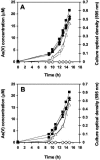A Na+:H+ antiporter and a molybdate transporter are essential for arsenite oxidation in Agrobacterium tumefaciens
- PMID: 16452441
- PMCID: PMC1367229
- DOI: 10.1128/JB.188.4.1577-1584.2006
A Na+:H+ antiporter and a molybdate transporter are essential for arsenite oxidation in Agrobacterium tumefaciens
Abstract
Transposon Tn5-B22 mutagenesis was used to identify genetic determinants required for arsenite [As(III)] oxidation in an Agrobacterium tumefaciens soil isolate, strain 5A. In one mutant, the transposon interrupted modB, which codes for the permease component of a high-affinity molybdate transporter. In a second mutant, the transposon insertion occurred in mrpB, which is part of a seven-gene operon encoding an Mrp-type Na+:H+ antiporter complex. Complementation experiments with mod and mrp operons PCR cloned from the genome-sequenced A. tumefaciens strain C58 resulted in complementation back to an As(III)-oxidizing phenotype, confirming that these genes encode activities essential for As(III) oxidation in this strain of A. tumefaciens. As expected, the mrp mutant was extremely sensitive to NaCl and LiCl, indicating that the Mrp complex in A. tumefaciens is involved in Na+ circulation across the membrane. Gene expression studies (lacZ reporter and reverse transcriptase PCR experiments) failed to show evidence of transcriptional regulation of the mrp operon in response to As(III) exposure, whereas expression of the mod operon was found to be up-regulated by As(III) exposure. In each mutant, the loss of As(III)-oxidizing capacity resulted in conversion to an arsenate [As(V)]-reducing phenotype. Neither mutant was more sensitive to As(III) than the parental strain.
Figures





Similar articles
-
Complex regulation of arsenite oxidation in Agrobacterium tumefaciens.J Bacteriol. 2006 Feb;188(3):1081-8. doi: 10.1128/JB.188.3.1081-1088.2006. J Bacteriol. 2006. PMID: 16428412 Free PMC article.
-
Involvement of the Acr3 and DctA anti-porters in arsenite oxidation in Agrobacterium tumefaciens 5A.Environ Microbiol. 2015 Jun;17(6):1950-62. doi: 10.1111/1462-2920.12468. Epub 2014 Apr 28. Environ Microbiol. 2015. PMID: 24674103
-
Proteomics and genetic analyses reveal the effects of arsenite oxidation on metabolic pathways and the roles of AioR in Agrobacterium tumefaciens GW4.Environ Pollut. 2018 Apr;235:700-709. doi: 10.1016/j.envpol.2018.01.006. Epub 2018 Jan 12. Environ Pollut. 2018. PMID: 29339339
-
Mrp Antiporters Have Important Roles in Diverse Bacteria and Archaea.Front Microbiol. 2017 Nov 23;8:2325. doi: 10.3389/fmicb.2017.02325. eCollection 2017. Front Microbiol. 2017. PMID: 29218041 Free PMC article. Review.
-
Molybdate transport and regulation in bacteria.Arch Microbiol. 1997 Nov;168(5):345-54. doi: 10.1007/s002030050508. Arch Microbiol. 1997. PMID: 9325422 Review.
Cited by
-
Single site mutations in the hetero-oligomeric Mrp antiporter from alkaliphilic Bacillus pseudofirmus OF4 that affect Na+/H+ antiport activity, sodium exclusion, individual Mrp protein levels, or Mrp complex formation.J Biol Chem. 2010 Oct 1;285(40):30942-50. doi: 10.1074/jbc.M110.118661. Epub 2010 Jul 12. J Biol Chem. 2010. PMID: 20624916 Free PMC article.
-
Involvement of RpoN in regulating bacterial arsenite oxidation.Appl Environ Microbiol. 2012 Aug;78(16):5638-45. doi: 10.1128/AEM.00238-12. Epub 2012 Jun 1. Appl Environ Microbiol. 2012. PMID: 22660703 Free PMC article.
-
Catalytic properties of Staphylococcus aureus and Bacillus members of the secondary cation/proton antiporter-3 (Mrp) family are revealed by an optimized assay in an Escherichia coli host.J Bacteriol. 2007 Apr;189(8):3081-90. doi: 10.1128/JB.00021-07. Epub 2007 Feb 9. J Bacteriol. 2007. PMID: 17293423 Free PMC article.
-
High-level chromate resistance in Arthrobacter sp. strain FB24 requires previously uncharacterized accessory genes.BMC Microbiol. 2009 Sep 16;9:199. doi: 10.1186/1471-2180-9-199. BMC Microbiol. 2009. PMID: 19758450 Free PMC article.
-
Autecology of an arsenite chemolithotroph: sulfide constraints on function and distribution in a geothermal spring.Appl Environ Microbiol. 2007 Nov;73(21):7067-74. doi: 10.1128/AEM.01161-07. Epub 2007 Sep 7. Appl Environ Microbiol. 2007. PMID: 17827309 Free PMC article.
References
-
- Afkar, E., J. Lisak, C. Saltikov, P. Basu, R. S. Oremland, and J. F. Stolz. 2003. The respiratory arsenate reductase from Bacillus selenitireducens strain MLS10. FEMS Microbiol. Lett. 226:107-112. - PubMed
-
- Ahmann, D., A. L. Roberts, L. R. Krumholz, and F. M. M. Morel. 1994. Microbe grows by reducing arsenic. Nature 371:750. - PubMed
-
- Anderson, G. L., J. Williams, and R. Hille. 1992. The purification and characterization of arsenite oxidase from Alcaligenes faecalis, a molybdenum-containing hydroxylase. J. Biol. Chem. 267:23674-23682. - PubMed
-
- Boos, W., and J. M. Lucht. 1996. Periplasmic binding protein-dependent ABC transporters, p. 1175-1209. In F. C. Neidhardt, R. Curtiss III, J. L. Ingraham, E. C. C. Lin, K. B. Low, B. Magasanik, W. S. Reznikoff, M. Riley, M. Schaechter, and H. E. Umbarger (ed.), Escherichia coli and Salmonella. Cellular and molecular biology, 2nd ed. ASM Press, Washington, D.C.
Publication types
MeSH terms
Substances
LinkOut - more resources
Full Text Sources
Research Materials

